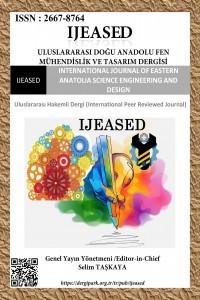Ev Tipi Set Üstü Gazlı Ocaklarda Maliyet ve Kalite İyileştirme Amaçlı Bir Değer Mühendisliği Uygulaması
Değer mühendisliği, Maliyet iyileştirmesi, Süreç iyileştirme, Kalite, Verimlilik
A Value Engineering Applicaton for Cost and Quality Improvement in Domestic Type Gas Hobs
Value Engineering, Cost improvement, Process improvement, Quality, Efficiency,
___
- Alkheribi, A.H,. (2017). A Framework for Value Engineering Methodology Application Using Building Information Modeling (BIM). Master Thesis, The Islamic University Gaza Higher Education Deanship Faculty of Engineering Civil Engineering Department Engineering Projects Management, Gaza.
- Abdulaziz, S., Al-Yousefi, CVS-Life, FSAVEI, (2011). Value engineering application benefits in sustainable construction. Riyadh: Project Management Institute Persian Gulf.
- Annappa, C. M., ve Panditrao, K. S., (2012). Application of value engineering for cost reduction-a case study of universal testing machine. International Journal of Advances in Engineering & Technology, 4(1), 618.
- Atabay, S., ve Galipogullari, N., (2013). Application of value engineering in construction projects. Journal of Traffic and Transportation Engineering, 1(1), 39-48.
- Chougule, A., Gupta, A. K., ve Patil, S., (2014). Application of value engineering technique to a residential building-case study. International Journal of Innovative Research in Advanced Engineering (IJIRAE), 1(12), 2349-2163.
- Dallas, M.F., (2006). Value and Risk Management A Guide to Best Practice, Lackwell Publishing Ltd, U.K.
- Farahmandazad, M., (2015). Developing a model for implementation of value engineering system for the construction projects of executing construction project-based companies (fourth factor) case study: construction projects of social security organization. Indian Journal of Fundamental and Applied Life Sciences, pp. 1403-1413.
- Jeyakumar, R., (2013). The Implementation and Effectiveness of Value Engineering in the United Arab Emirates. Doctoral dissertation, University of Glamorgan / Prifysgol Morgannwg Faculty of Advanced Technology for the Degree of Doctor of Philosophy, Pontypridd, England.
- Kelly, J., Male, S., ve Graham.D., (2004). Value Management of construction projects, Blackwell Publishing, 2nd Edition, United Kingdom.
- Kelly, J., Male, S.,ve Graham, D. (2014). Value management of construction projects. John Wiley & Sons, Blackwell Science, USA.
- Kelly, J., Morledge, R., ve Wilkinson, S. J., (2009). Best value in construction. John Wiley & Sons, Blackwell Science, USA.
- Rane, N. L., & Attarde, P. M. (2016). Application of Value Engineering in Commercial Building Projects. International Journal of Latest Trends in Engineering and Technology (IJLTET), 6(3), pp. 286-291.
- Rich, N., & Holweg, M. (2000). Value analysis/value engineering. Report produced for the EC funded project. INNOREGIO: dissemination of innovation and knowledge management techniques, Lean Enterprise Research Centre, Cardiff, UK.
- Seeley, I. H., (1972). Building economics: appraisal and control of building design cost and efficiency. Macmillan International Higher Education, University California.
- Shekari, A., ve Fallahian, S., (2007). A new approach to linking value engineering & lean methodology. In Proceedings of the 19th International Conference on Production Research, Valparaiso, pp. 29-31.
- ISSN: 2667-8764
- Başlangıç: 2019
- Yayıncı: Selim TAŞKAYA
ARCGIS Yazılımı ile Kıyı Bilgi Sistemi Sayısallaştırma Uygulaması, Gökova Örneği
Aybegüm NUMANOĞLU, Orhan ERDEN
Selim TAŞKAYA, Faik Ahmet SESLİ
Ferro Alaşımların Genel Yapısı ve Ferro Molibden (FeMo) İstihsali
MapInfo Yazılımı ile Tematik Haritaların Üretilmesi, Konya İli Örneği
Neslişah ULUTAŞ, Ahmet TANRIVERDİ
Konya İli Ilgın İlçesindeki Katı Atık Depolama Noktalarının Haritalandırılması
